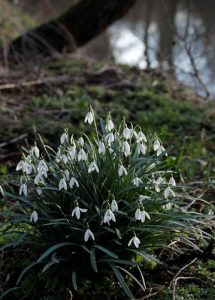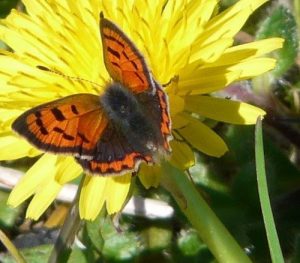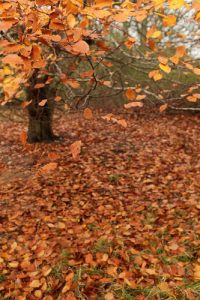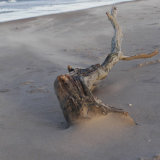Situated on the northern fringe of the agricultural coastal plain of East Lothian, Dirleton is a great staging post to explore the beautiful beaches, sand dunes and woodlands found on its doorstep.
Some notes by season :
 Snowdrops
SnowdropsPrimroses, bluebells and the intoxicating aroma of wild garlic are the hallmark of springtime in the woodlands.
Migrant birds such as sand martins and swallows can be seen flitting northwards along the coast, while later on whitethroats are to be heard singing scratchily from scrubland. The song of chiff chaffs and willow warblers melodically fill the airspace and on warmer days take advantage of the emerging insects. One of whom, the dangly legged St Marks fly, can be seen in large numbers while trying to attract a mate. They can be a bit annoying but are useful pollinators of plants, trees and crops.

At Yellowcraig during early-mid summer an array of orchids are on show. The earlier-emerging deep purple northern marsh orchids are usurped in July by the delicate common spotted orchids. Twayblades abound in the turf nursery area where a keen eye can distinguish the less obvious and more delicate frog orchid.
Invertebrates delight throughout the site. Speckled wood butterflies can be seen dancing in the dappled shade of woodland glades, while in the dunes the crimson winged cinnabar moths bright small copper butterflies, among many others, can be seen flitting between the myriad of dune grassland flowers.
Along the shoreline, eider ducks can be found in large flocks. Look out for the (brown) females looking after their chicks in crèches. Many of the males (black and white) will be flightless as they moult their feathers, giving them a somewhat dishevelled appearance.


The onset of autumn brings with it the familiar di-syllabic calls of the pink footed geese as they stop off on their migration south. Occasionally mixing with the locally common greylag goose, they will feed in the fields by day before returning to Aberlady Bay to roost each night. Numbers locally can reach 30,000+ and witnessing large skeins pass over is an awe inspiring experience.
Bats will be seen only on warmer nights now as they seek out hibernation sites, but their presence is replaced by other birdlife arriving on our shores. Short eared owls and a diverse range of other migratory birds can be seen and heard along the coast at this time of year so pack your binoculars and bird book if heading out.

Stands of Sea Buckthorn in Archerfield estate and along the coast provide excellent food for an array of wintering birds, particularly thrushes such as fieldfare and redwing which can arrive in huge numbers from the continent to feed on these stocks. Their respective ‘chuckling’ and ‘seeep’ calls are commonly heard at this time of year. They descend to feed on shrubs including sea buckthorn also known as the ‘baked bean bush’, which is found in many areas along the coast.
A trip along the shoreline will reveal a range of wading birds which overwinter along the rocky coastline of the Firth of Forth. These include the characterful sanderling, oystercatcher and the brightly legged redshank. You may even spot a sparrowhawk darting out from cover in the search for prey.
